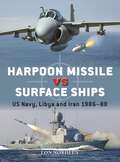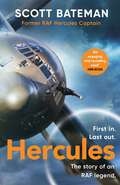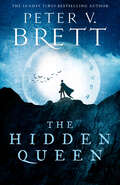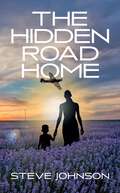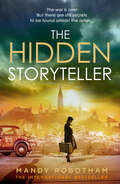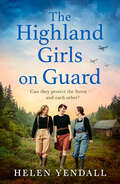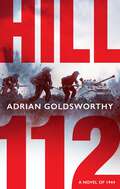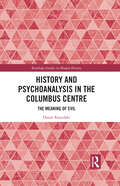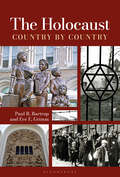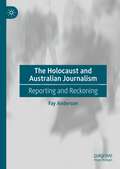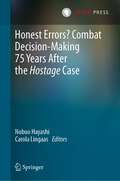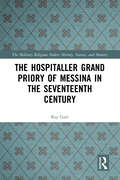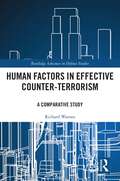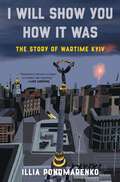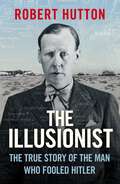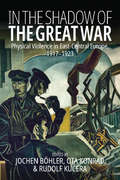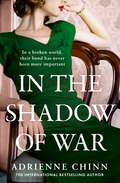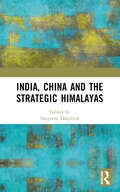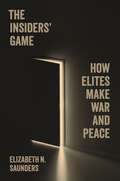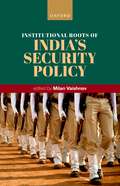- Table View
- List View
Harpoon Missile vs Surface Ships: US Navy, Libya and Iran 1986–88 (Duel #134)
by Lon NordeenAn illustrated study of premier US anti-ship missile, the AGM/RGM-84 Harpoon, and its 1986 and '88 uses against Libyan and Iranian naval vessels.In this study, defence technology expert Lon Nordeen details the role played by the Harpoon missile in two Cold War flare-ups in the 1980s. The Harpoon was the first tactical anti-ship missile developed by the US Navy to provide a counter to the anti-ship missiles exported around the world by the Soviet Union and China. It was deployed on ships, aircraft, submarines and land vehicles and soon became the most widely used anti-ship missile system in the West, with 7,000+ having been produced since 1977, operated by the military forces of more than 30 nations. This exciting book explores the engagements of the Harpoon by the US Navy against its Libyan and Iranian adversaries, using original photographs and specially commissioned artwork to examine the naval systems and weapons employed by both counterparts. Drawing upon interviews with the US Navy A-6 Intruder crews that deployed the AGM084 variant of the Harpoon in 1986 and 1988, the author brings unique insight to his examination of these fascinating duels.
Hercules: An action-packed insider’s account of what it’s like to fly in the RAF's Hercules
by Scott BatemanRead the legendary story of the Lockheed C-130 Hercules aircraft, seen through the eyes of former RAF captain Scott Bateman'An engaging and revealing read' JOHN NICHOL---Anytime, Anywhere, Anyhow. Whether it’s war, natural disaster, or humanitarian emergency, for over fifty years the RAF’s Hercules force was the first in and last out of any crisis faced by the UK government around the globe.First conceived in the 1950s, the US-built Lockheed C-130 Hercules earned its spurs flying difficult and dangerous missions in the Vietnam War before entering service with air forces around the world. Originally designed as transport aircraft, the Hercules has been pressed into service as an aerial tanker, gunship, spyplane, air-sea rescuer and bomber.Instantly recognisable, it became synonymous with daring special forces missions like the legendary raid in Entebbe in which dozens of hostages were rescued from the clutches of terrorists. In RAF colours it's seen action on every continent on the planet including Antarctica, flying life and death missions in the Falklands, Lebanon, Iraq, Libya, Afghanistan, Sudan and all points in between.Former RAF Hercules Captain Scott Bateman opens the cockpit to give an action-packed insider’s account of what it’s like to fly this legendary flying machine in peace and war, and at home and abroad, paying tribute to the remarkable men and women who operated this much loved aircraft, and to those comrades in arms who, in doing so, made the ultimate sacrifice.
The Hidden Queen (The Nightfall Saga #2)
by Peter V. BrettThe second book in the Nightfall Saga, the stunning new epic fantasy series set in the world of the Demon Cycle, from New York Times bestselling author Peter V. Brett.
The Hidden Road Home
by Steve JohnsonLondon 1939. With a global conflict on the horizon, 19-year-old waitress, Charlotte Reid meets 21-year-old fighter pilot Tom Hammond. They soon realise that they have something special and after a short engagement, they marry, just after war with Germany is declared. The fall of France puts the Luftwaffe within striking range, and Tom in the thick of the action during the Battle of Britain. Both he and his young wife are taken through every nerve-shredding emotion as the fight for air superiority intensifies. If the Germans achieve their goal of totally destroying the RAF, then invasion would be the likely outcome. With fighter pilot casualty rates so high will Tom Hammond be one of the lucky ones or will the future he has planned with Charlotte literally go up in smoke? If that were to happen, how would she cope with grief at such a young age? Could she cope? War asks some tough questions of love. Is it stronger than fear? Stronger than hate? Stronger than death even? As the bloodiest conflict in history got underway, millions of people, including Tom and Charlotte, didn't know the answers. But they were about to find out.
The Hidden Storyteller
by null Mandy RobothamInternational bestselling author Mandy Robotham returns with a brand new tale set in war-torn Germany. The war is over. But there are still secrets to be found amidst the ashes . . . Hamburg, 1946 The war is over, and Germany is in ruins. Posted to an Allied-run Hamburg, reporter Georgie Young returns to the country she fled seven years prior – at the onset of the conflict – to find it unrecognisable. Amongst the stark horrors of a bombed-out city crumbling under the weight of millions of displaced souls, she discovers pockets of warmth: a violinist playing amidst the wreckage, couples dancing in the streets, and a nation trying to make amends. Joining forces with local detective Harri Schroder to catch a killer targeting women on the city’s streets, curiosity draws Georgie deep into the dark underbelly, and she soon discovers that some secrets of war did not die with Hitler… The next gripping and heart-wrenching historical fiction novel from international bestseller, Mandy Robotham. Readers love Mandy Robotham: ‘Evocative and emotive, a real must-read. Both harrowing and very moving. I couldn’t put it down’ Real Reader Review, ⭐⭐⭐⭐⭐ ‘I really liked the crime element in the story. This book will stay with me. Great writing – very poignant and heart-wrenching’ Real Reader Review, ⭐⭐⭐⭐⭐ ‘This is a really great book, full of interesting characters that you want to survive’ Real Reader Review, ⭐⭐⭐⭐⭐ ‘A thoroughly entertaining read. Strongly recommended’ Real Reader Review, ⭐⭐⭐⭐⭐ ‘Another excellent novel by Mandy Robotham! A thriller with a dash of historical fiction. It was very well written, and she had me on the edge of my seat the whole way through’ Real Reader Review, ⭐⭐⭐⭐⭐ ‘An informative, compassionate read of historical fiction. Highly recommended’ Real Reader Review, ⭐⭐⭐⭐⭐
The Highland Girls on Guard (The Highland Girls series #2)
by Helen Yendall‘Had me hooked from the start and I got so involved with the characters I couldn’t stop reading’ Vicki Beeby Scotland, 1943. It’s a long hot summer in Scotland but the Women’s Timber Corps have more than forest fires to worry about.
Hill 112: a novel of D-Day and the Battle of Normandy
by Adrian GoldsworthyA gripping story of friendship and division in the midst of warfare, set against one of the most dramatic, dangerous, and crucial campaigns of World War II: the Battle of Normandy. They went to war as boys. Will they make it home as men?D-Day. June 6th, 1944. The trajectory of the Second World War – and with it the course of modern history – is changed for ever.For three young former schoolmates from South Wales, their war is only just beginning.James was the school cricket captain. Now, a few short years later, he is in charge of a troop of Sherman tanks.Mark, just nineteen, must lead a platoon of infantrymen into battle.And Bill, always something of a loner, sees the heart of the fighting as a private soldier.These young men, and thousands of others, will soon be a part of one of the bloodiest and most brutal parts of the Normandy campaign: the battle for Hill 112. The horror, the fear, the filth; the savage fighting; the sheer exhilaration and moments of farce and laughter: those who come through the carnage will never be the same again.From critically acclaimed author and historian Adrian Goldsworthy, Hill 112 is based on real events and the records and reminiscences of those who were there. Published to coincide with the eightieth anniversary of D-Day, Hill 112 is perfect for fans of Robert Harris and Simon Scarrow.
History and Psychoanalysis in the Columbus Centre: The Meaning of Evil (Routledge Studies in Modern History)
by Danae KarydakiThis book draws on a range of key archives and oral testimonies to provide the first systematic and historical study of the origins, context, development, frustrations, inner contradictions, and legacies of the Columbus Centre. The Columbus Centre, a remarkable though largely forgotten research institute, was established at the University of Sussex in 1966, triggered by claims of a dearth of academic research about Nazism and the Holocaust. Its basic stated aim was to bring together psychoanalysis and history for a scholarly investigation of discrimination, mass violence, and the preconditions of genocide in the past and the present. The Nazi crimes were studied along with other instances of prejudice and mass violence, such as sixteenth- and seventeenth-century witch-hunts, South African apartheid, the persecution of the Roma people, and race relations in the United States and modern-day Britain. The book seeks to place the Columbus Centre in the historiography of mass violence by analysing the Centre’s works through four historiographical prisms or power relations in which they were produced: psychoanalysis, class, race, and gender. This interdisciplinary volume is a valuable text for scholars and students of historiography, psychoanalysis, genocide and violence, and postwar Europe, and for professionals within the field of psychology.
History and Psychoanalysis in the Columbus Centre: The Meaning of Evil (Routledge Studies in Modern History)
by Danae KarydakiThis book draws on a range of key archives and oral testimonies to provide the first systematic and historical study of the origins, context, development, frustrations, inner contradictions, and legacies of the Columbus Centre. The Columbus Centre, a remarkable though largely forgotten research institute, was established at the University of Sussex in 1966, triggered by claims of a dearth of academic research about Nazism and the Holocaust. Its basic stated aim was to bring together psychoanalysis and history for a scholarly investigation of discrimination, mass violence, and the preconditions of genocide in the past and the present. The Nazi crimes were studied along with other instances of prejudice and mass violence, such as sixteenth- and seventeenth-century witch-hunts, South African apartheid, the persecution of the Roma people, and race relations in the United States and modern-day Britain. The book seeks to place the Columbus Centre in the historiography of mass violence by analysing the Centre’s works through four historiographical prisms or power relations in which they were produced: psychoanalysis, class, race, and gender. This interdisciplinary volume is a valuable text for scholars and students of historiography, psychoanalysis, genocide and violence, and postwar Europe, and for professionals within the field of psychology.
The Holocaust: Country by Country
by Eve E. Grimm Professor Paul R. BartropFrom genocidal campaigns to careful neutrality to valiant lifesaving efforts, every country's experience of the Holocaust was different during and immediately following World War II.This book profiles 50 nations and territories from around the globe, examining how prewar conditions and attitudes toward Jews influenced the trajectory of that place's wartime experience and its role in the Holocaust. It also explores the aftermath and lasting impact of the Holocaust in these places. Each profile begins with a collection of at-a-glance facts about population, government leaders, wartime status, and more. All profiles begin with a brief introduction, followed by information about the Jewish population in that place, the prewar environment, wartime experiences, and the aftermath of the Holocaust. This standardized format makes it easy for readers to find specific information while also helping them place events within the proper historical context. A curated selection of further readings at the end of each profile and an end-of-volume list of books and Internet resources point readers toward materials for additional study.While often conceptualized as a single event that happened the same way across all Axis or Axis-occupied countries, the Holocaust and reactions to it varied widely from country to country. In many cases, political and economic conditions in the prewar years, as well as the degree of anti-Semitism in a nation, influenced that country's experience of the Holocaust. Even after the war, countries experienced the aftermath of the Holocaust in different ways. Some places, such as Palestine, became a beacon for Jewish refugees, while others, such as Brazil, became a hideout for Nazi war criminals.
The Holocaust and Australian Journalism: Reporting and Reckoning
by Fay AndersonThis book explores the Australian press reporting of the persecution and genocide of European Jews, and the extent to which the news of the Holocaust was known and believed, revealed and hidden, and acknowledged and minimised. Spanning the coverage of Hitler’s political ascent in the 1920s through to the Nazis’ extermination campaign, it culminates in the accounts of the trials of Nazi war criminals and the post-war transnational migration to Australia of Holocaust survivors, to a country far from universally welcoming in its reception of them. The book also tells the story of the journalists who reported on these tragic events and the editors who published them, along with the political, social and cultural context in which they worked, in an environment influenced by exclusionary ideas about race and nationality that did not necessarily inspire sympathy for Jews and their trauma. This book sheds light on the ethics of reporting human suffering, violence and genocide and – centrally – on the role of the press in shaping Australia’s collective memory of the Holocaust. It encourages readers to think critically about media power, public apathy, advocacy, and the importance of truth. Disturbing evidence of increasing anti-Semitism in Australia as elsewhere, along with continuing Holocaust denial, provide an additional urgency to this study.
Honest Errors? Combat Decision-Making 75 Years After the Hostage Case
by Nobuo Hayashi Carola LingaasThis book marks the 75th anniversary of the 1948 Hostage Case in which a US military tribunal in Nuremberg acquitted General Lothar Rendulic of devastating Northern Norway on account of his honest factual error. The volume critically reappraises the law and facts underlying his trial, the no second-guessing rule in customary international humanitarian law (IHL) that is named after the general himself, and the assessment of modern battlefield decisions.Using recently discovered documents, this volume casts major doubts on Rendulic’s claim that he considered the region’s total devastation and the forcible evacuation of all of its inhabitants imperatively demanded by military necessity at the time. This book’s analysis of court records reveals how the tribunal failed to examine relevant facts or explain the Rendulic Rule’s legal origin. This anthology shows that, despite the Hostage Case’s ambiguity and occasional suggestions to the contrary, objective reasonableness forms part of the reasonable commander test under IHL and the mistake of fact defence under international criminal law (ICL) to which the rule has given rise. This collection also identifies modern warfare’s characteristics—human judgment, de-empathetic battlespace, and institutional bias—that may make it problematic to deem some errors both honest and reasonable. The Rendulic Rule embodies an otherwise firmly established admonition against judging contentious battlefield decisions with hindsight. Nevertheless, it was born of a factually ill-suited case and continues to raise significant legal as well as ethical challenges today.The most comprehensive study of the Rendulic Rule ever to appear in English, this multi-disciplinary anthology will appeal to researchers and practitioners of IHL and ICL, as well as military historians and military ethicists and offers ground-breaking new research.Nobuo Hayashi is affiliated to the Centre for International and Operational Law at the Swedish Defence University in Stockholm, Sweden.Carola Lingaas is affiliated to the Faculty of Social Studies at VID Specialized University in Oslo, Norway.
The Hospitaller Grand Priory of Messina in the Seventeenth Century (ISSN)
by Ray GattThis book details the origin of the Grand Hospitaller Priory of Messina. It discusses a breadth of themes, such as the historiography, the Hospitaller’s European commandery and Sicilian patrimony, its management and organization in the seventeenth century, its religious practices, and the prioral mansion in Messina. The final chapter includes a detailed account of the 1674 Messina insurrection against the Spanish overlords. This event plunged the priory into political chaos, fracturing it and pitting members against each other. It also shattered neutrality issues embedded in the statutes of the religion and ignoring the precepts emanating from the Convent on Malta.The Hospitaller Grand Priory of Messina in the Seventeenth Century will appeal to students and scholars alike interested in the Crusading Orders, the history of the Knights Hospitaller, and the history of Malta.
The Hospitaller Grand Priory of Messina in the Seventeenth Century (ISSN)
by Ray GattThis book details the origin of the Grand Hospitaller Priory of Messina. It discusses a breadth of themes, such as the historiography, the Hospitaller’s European commandery and Sicilian patrimony, its management and organization in the seventeenth century, its religious practices, and the prioral mansion in Messina. The final chapter includes a detailed account of the 1674 Messina insurrection against the Spanish overlords. This event plunged the priory into political chaos, fracturing it and pitting members against each other. It also shattered neutrality issues embedded in the statutes of the religion and ignoring the precepts emanating from the Convent on Malta.The Hospitaller Grand Priory of Messina in the Seventeenth Century will appeal to students and scholars alike interested in the Crusading Orders, the history of the Knights Hospitaller, and the history of Malta.
Human Factors in Effective Counter-Terrorism: A Comparative Study (Routledge Advances in Defence Studies)
by Richard WarnesThis book seeks to provide a comparative assessment of the significance of ‘human factors’ in effective counter-terrorism. The phrase ‘human factors’ is used to describe personal relationships, individual capabilities, effective leadership, technical interface, organisational culture and the community engagement necessary to effectively minimise, counter and control the threat of terrorism. Unlike many works in the field, this book is constructed around the input of ‘experienced knowledge’ from over 170 semi-structured interviews of specialist military, policing, intelligence and security practitioners - those actors actually involved in countering terrorism. These practitioners come from seven countries – the United Kingdom, Ireland, France, Spain, Israel, Turkey and the United States – all of which have suffered over the years from different types of terrorist threat and responded with a mixture of counter-terrorist measures. Where military practitioners also discussed overseas counter-insurgency measures, that material has been included, since terrorism forms a key aspect of such wider insurgencies. The resulting interview data was analysed through a variant of ‘Grounded Theory’ to identify key emerging themes and issues, both positive and negative, relevant to ‘human factors’ in the individual countries and more generically. This book incorporates the informed operational experiences and insights of the interviewees while seeking to provide examples of successful counter-terrorist measures at the strategic, operational and tactical levels. This book will be of much interest to students of counter-terrorism, defence studies and security studies in general.
Human Factors in Effective Counter-Terrorism: A Comparative Study (Routledge Advances in Defence Studies)
by Richard WarnesThis book seeks to provide a comparative assessment of the significance of ‘human factors’ in effective counter-terrorism. The phrase ‘human factors’ is used to describe personal relationships, individual capabilities, effective leadership, technical interface, organisational culture and the community engagement necessary to effectively minimise, counter and control the threat of terrorism. Unlike many works in the field, this book is constructed around the input of ‘experienced knowledge’ from over 170 semi-structured interviews of specialist military, policing, intelligence and security practitioners - those actors actually involved in countering terrorism. These practitioners come from seven countries – the United Kingdom, Ireland, France, Spain, Israel, Turkey and the United States – all of which have suffered over the years from different types of terrorist threat and responded with a mixture of counter-terrorist measures. Where military practitioners also discussed overseas counter-insurgency measures, that material has been included, since terrorism forms a key aspect of such wider insurgencies. The resulting interview data was analysed through a variant of ‘Grounded Theory’ to identify key emerging themes and issues, both positive and negative, relevant to ‘human factors’ in the individual countries and more generically. This book incorporates the informed operational experiences and insights of the interviewees while seeking to provide examples of successful counter-terrorist measures at the strategic, operational and tactical levels. This book will be of much interest to students of counter-terrorism, defence studies and security studies in general.
I Will Show You How It Was: The Story of Wartime Kyiv
by Illia Ponomarenko"A story of searing clarity from Ukraine's frontlines of an unfathomably resilient, freedom loving people who refuse to bend to Putin's assault on truth and human life."-Nicole Perlroth“Destined to become a classic of modern war reporting.”-Luke HardingA raw, irreverent account of a young Ukrainian reporter on-the-ground as his country heroically defends itself against the Russian invasion. In late February 2022, a series of missiles and rocket strikes began falling upon Ukraine, as the Russian military barreled over the border and fanned out across the country. First they took Chernobyl, then Kherson, then Mariupol. Time stood still as the world waited for Ukraine to flatten underneath the boot of its neighbor. Meanwhile, on the front lines in the capital city, Kyiv Independent reporter Illia Ponomarenko was seeing a different story on unfold: after months-years-of waiting for this long-feared attack, Ukraine was fed up and ready to fight back. The Russians bogged down hard in combat east and west of Kyiv. They got exhausted. They screwed up logistics. They sustained heavy losses. Their unbelievably overconfident blitz was failing. I Will Show You How It Was is Illia Ponomarenko's heart-wrenching memoir of the war on his homeland, offering a fiery diatribe against Russian hypocrisy and a moving look at what is being lost. But it's also a story of pride and even elation as Ukrainian forces come together, find their mojo, and oust the invaders from Kyiv. The most powerful and personal chronicle of the war to date, I Will Show You How It Was is an exceptional literary achievement, chronicling a stunning feat of resistance and a courageous people set on a miraculous victory.
The Illusionist: The True Story of the Man Who Fooled Hitler
by Robert HuttonCairo, 1942: If you had asked a British officer who Colonel Clarke was, they would have been able to point him out: always ready with a drink and a story, he was a well-known figure in the local bars. If you then asked what he did, you would have less success. Those who knew didn't tell, and almost no one really knew at all.Clarke thought of himself as developing a new kind of weapon. Its components? Rumour, stagecraft, a sense of fun. Its target? The mind of Erwin Rommel, Hitler's greatest general. Throughout history, military commanders have sought to mislead their opponents. Dudley Clarke set out to do it on a scale no one had imagined before. Even afterwards, almost no one understood the magnitude of his achievement. Drawing on recently released documents and hugely expanding on the louche portrait of Clarke as seen in SAS: Rogue Heroes, journalist and historian Robert Hutton reveals the amazing story of Clarke's A Force, the invention of the SAS and the Commandos, and the masterful hoodwinking of the Desert Fox at the battle of El Alamein. The Illusionist tells for the first time the dazzling tale of how, at a pivotal moment in the war, British eccentricity and imagination combined to thwart the Nazis and save innumerable lives - on both sides.
In the Shadow of the Great War: Physical Violence in East-Central Europe, 1917–1923
by Jochen Böhler, Ota Konrád, and Rudolf KučeraWhether victorious or not, Central European states faced fundamental challenges after the First World War as they struggled to contain ongoing violence and forge peaceful societies. This collection explores the various forms of violence these nations confronted during this period, which effectively transformed the region into a laboratory for state-building. Employing a bottom-up approach to understanding everyday life, these studies trace the contours of individual and mass violence in the interwar era while illuminating their effects upon politics, intellectual developments, and the arts.
In the Shadow of War (The Three Fry Sisters #3)
by null Adrienne Chinn‘An emotive and engaging read’ Bestselling author Rosanna Ley One war may be over, but their fight for survival continues… For sisters Etta, Jessie and Celie Fry, the Great War and the hardships of the years that followed have taken a heavy toll. Determined to leave her painful past behind her, Etta heads to the bright lights of Hollywood whilst Jessie, determined to train as a doctor and use her skills to help others, is hampered by the men who dominate her profession. On the vast, empty plains of the Canadian prairies, Celie and her small family stand on the brink of losing everything. As whispers of a new war make their way to each sister, each must face the possibility of the unthinkable happening again… Praise for Adrienne Chinn: 'Rich, evocative and utterly immersive, this beautifully written book swept me away' Jenny Ashcroft, author of Meet Me in Bombay 'It is one of those books that you can't put down but also don't want to finish too soon!’ ⭐⭐⭐⭐⭐ 'An excellent read which once started was impossible to put down. I’m so hoping for book 4! Highly recommend this series’ ⭐⭐⭐⭐⭐ 'Brilliant storytelling. Highly recommended. I can't wait for the next one.' ⭐⭐⭐⭐⭐ 'Fabulous characters and storylines which bring in aspects of real history. Superb storytelling.’ ⭐⭐⭐⭐⭐ 'An excellent read which, once started, was impossible to put down. Highly recommend this series.’ ⭐⭐⭐⭐⭐ 'A fantastic book which kept me enthralled all the way through.’ ⭐⭐⭐⭐⭐
India, China and the Strategic Himalayas
by Sangeeta ThapliyalThis book analyses strategic discourse on the Himalayas from the perspective of India’s interests. Home to many communities, cultures, natural resources and political boundaries, it is the geopolitical landscape of the Himalayas between India and China that dominates other narratives and discourses. The traditional notion of Himalayas as India’s frontiers and buffer is challenged by China. Despite various mechanisms to address border resolution there are violations and transgressions from China. This book examines India’s responses to the new emerging challenges in the Himalayas. How the statist discourse on strategic interests incorporates people’s discourse. It provides a nuanced understanding of India’s strategic undertakings, diplomatic initiatives and development framework. This book will be a valuable addition to existing knowledge on the Himalayas between India and China. Scholars and practitioners interested in International Relations, Strategic Studies, Himalayan Studies and South Asian Studies will find it useful. Print edition not for sale in South Asia (India, Sri Lanka, Nepal, Bangladesh, Pakistan and Bhutan)
India, China and the Strategic Himalayas
This book analyses strategic discourse on the Himalayas from the perspective of India’s interests. Home to many communities, cultures, natural resources and political boundaries, it is the geopolitical landscape of the Himalayas between India and China that dominates other narratives and discourses. The traditional notion of Himalayas as India’s frontiers and buffer is challenged by China. Despite various mechanisms to address border resolution there are violations and transgressions from China. This book examines India’s responses to the new emerging challenges in the Himalayas. How the statist discourse on strategic interests incorporates people’s discourse. It provides a nuanced understanding of India’s strategic undertakings, diplomatic initiatives and development framework. This book will be a valuable addition to existing knowledge on the Himalayas between India and China. Scholars and practitioners interested in International Relations, Strategic Studies, Himalayan Studies and South Asian Studies will find it useful. Print edition not for sale in South Asia (India, Sri Lanka, Nepal, Bangladesh, Pakistan and Bhutan)
The Insiders’ Game: How Elites Make War and Peace (Princeton Studies in International History and Politics #208)
by Elizabeth N. SaundersHow elites shape the use of force in American foreign policyOne of the most widely held views of democratic leaders is that they are cautious about using military force because voters can hold them accountable, ultimately making democracies more peaceful. How, then, are leaders able to wage war in the face of popular opposition, or end conflicts when the public still supports them? The Insiders&’ Game sheds light on this enduring puzzle, arguing that the primary constraints on decisions about war and peace come from elites, not the public.Elizabeth Saunders focuses on three groups of elites—presidential advisers, legislators, and military officials—to show how the dynamics of this insiders&’ game are key to understanding the use of force in American foreign policy. She explores how elite preferences differ from those of ordinary voters, and how leaders must bargain with elites to secure their support for war. Saunders provides insights into why leaders start and prolong conflicts the public does not want, but also demonstrates how elites can force leaders to change course and end wars.Tracing presidential decisions about the use of force from the Cold War through the wars in Iraq and Afghanistan, Saunders reveals how the elite politics of war are a central feature of democracy. The Insiders&’ Game shifts the focus of democratic accountability from the voting booth to the halls of power.
The Insiders’ Game: How Elites Make War and Peace (Princeton Studies in International History and Politics #208)
by Elizabeth N. SaundersHow elites shape the use of force in American foreign policyOne of the most widely held views of democratic leaders is that they are cautious about using military force because voters can hold them accountable, ultimately making democracies more peaceful. How, then, are leaders able to wage war in the face of popular opposition, or end conflicts when the public still supports them? The Insiders&’ Game sheds light on this enduring puzzle, arguing that the primary constraints on decisions about war and peace come from elites, not the public.Elizabeth Saunders focuses on three groups of elites—presidential advisers, legislators, and military officials—to show how the dynamics of this insiders&’ game are key to understanding the use of force in American foreign policy. She explores how elite preferences differ from those of ordinary voters, and how leaders must bargain with elites to secure their support for war. Saunders provides insights into why leaders start and prolong conflicts the public does not want, but also demonstrates how elites can force leaders to change course and end wars.Tracing presidential decisions about the use of force from the Cold War through the wars in Iraq and Afghanistan, Saunders reveals how the elite politics of war are a central feature of democracy. The Insiders&’ Game shifts the focus of democratic accountability from the voting booth to the halls of power.
Institutional Roots of India's Security Policy
by Milan VaishnavIn recent years, India has asserted its desire not simply to be a balancing power but to become a leading power on the world stage. As India's economic development has steadily progressed, so too have its foreign policy and security ambitions. However, India's ability to sustain high rates of economic growth at home and project power overseas rests on unsteady state capacities. Despite widespread concerns over the severe institutional constraints that India faces, there is a lack of scholarly research on the administrative and organizational effectiveness of India's security institutions. Myriad inadequacies related to both procedure and personnel continue to hamper the Indian state's ability to perform one of its most essential functions: protecting Indians from security threats at home and abroad. Institutional Roots of India's Security Policy aims to deconstruct and interrogate disparities in India's security institutions through high-quality analytic examinations of more than a dozen foreign policy and national security institutions spread across four domains: the armed services, intelligence, border and internal security, and police and investigative agencies. A one-stop resource on India's security institutions, this volume demystifies secretive institutions that have long eluded careful scrutiny, including India's paramilitary forces, the Intelligence Bureau (IB), the Research and Analysis Wing (R&AW), and the Central Bureau of Investigation (CBI).
